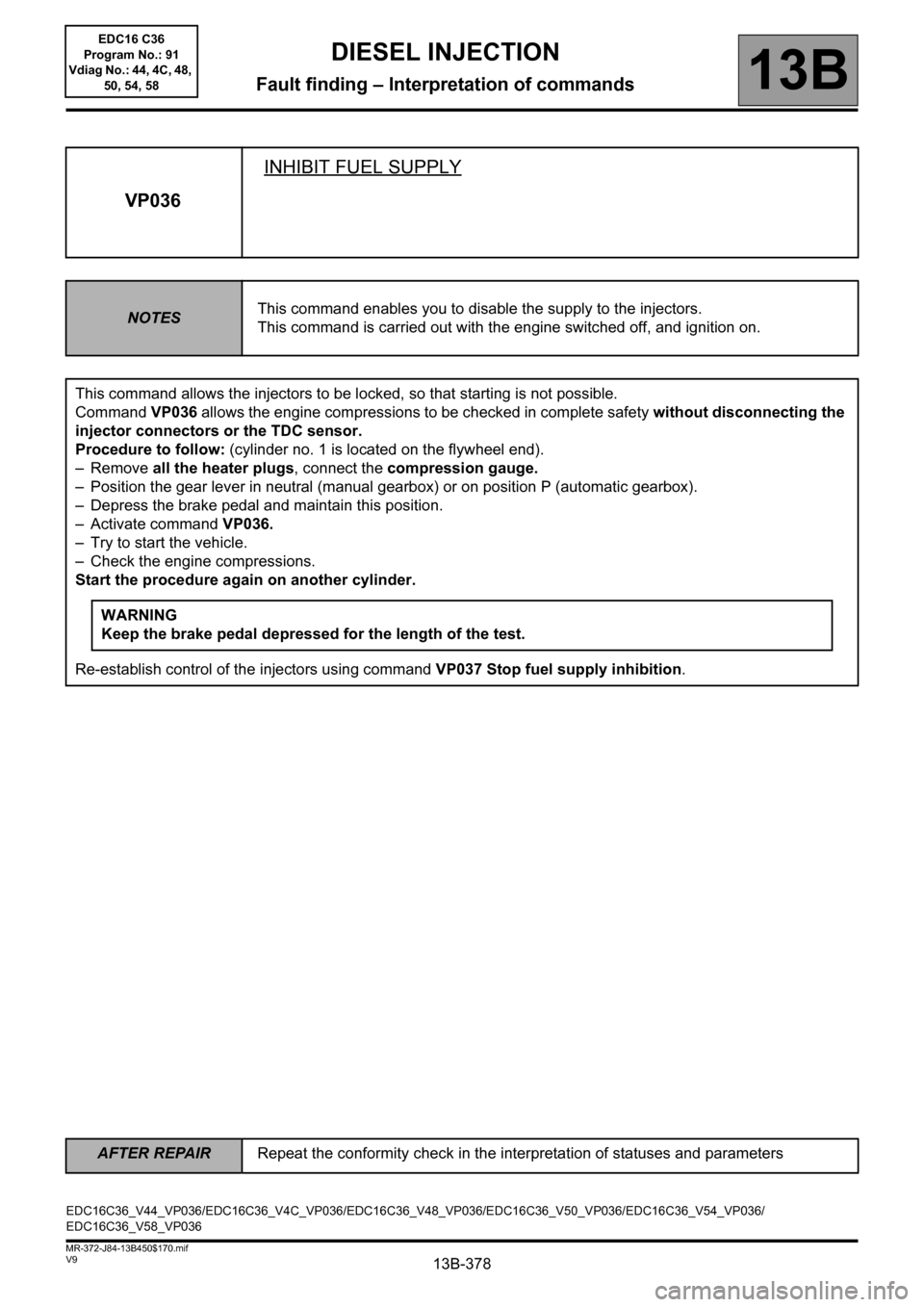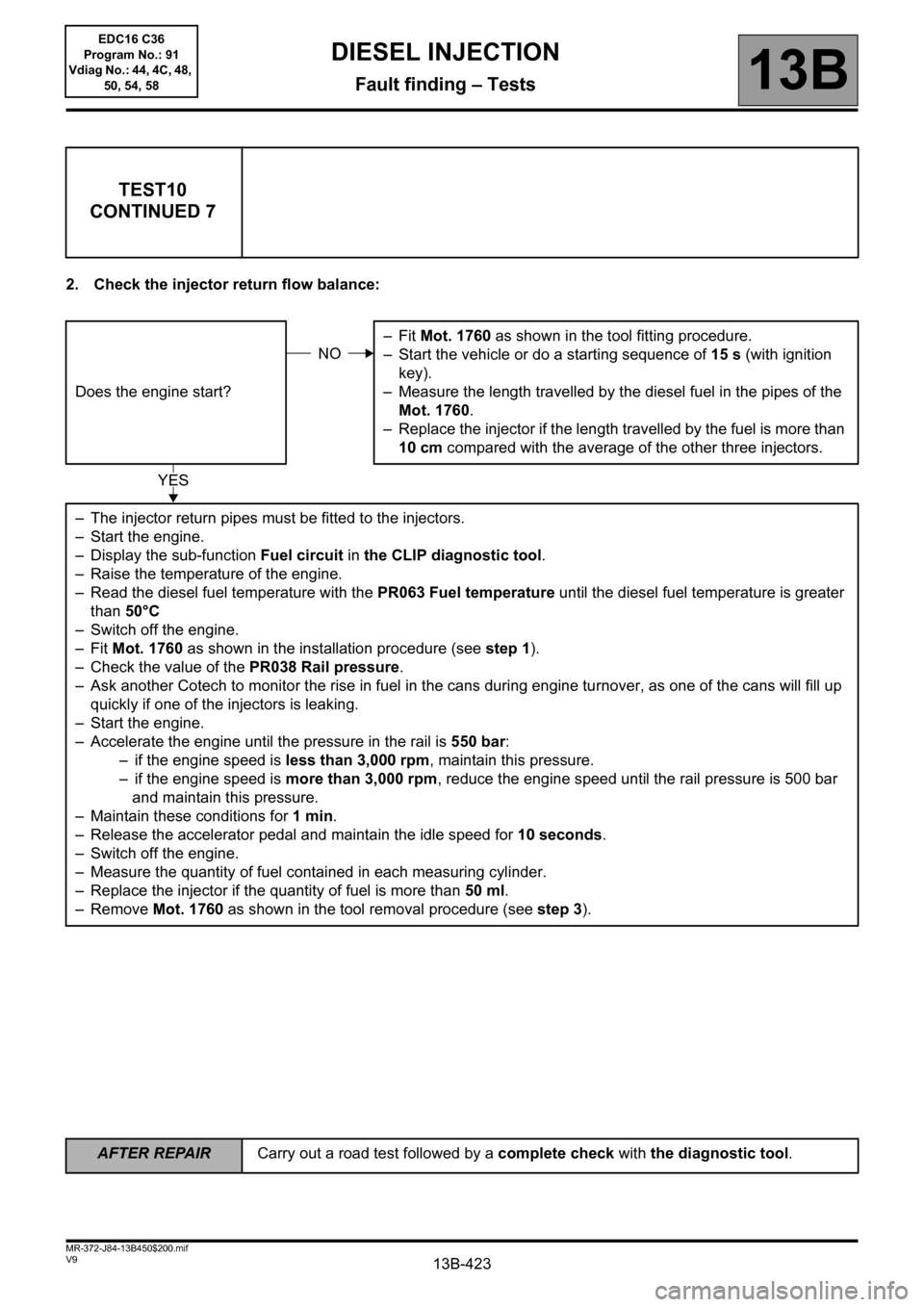length RENAULT SCENIC 2011 J95 / 3.G Engine And Peripherals EDC16C36 Workshop Manual
[x] Cancel search | Manufacturer: RENAULT, Model Year: 2011, Model line: SCENIC, Model: RENAULT SCENIC 2011 J95 / 3.GPages: 431, PDF Size: 2.03 MB
Page 20 of 431

13B-20V9 MR-372-J84-13B450$050.mif
DIESEL INJECTION
Fault finding – Features13B
EDC16 C36
Program No.: 91
Vdiag No.: 44, 4C, 48,
50, 54, 58
Exhaust gas recirculation management:
The EGR (Exhaust Gas Recirculation) system involves removing exhaust gases and reintroducing them into the
inlet.
The exhaust gases are collected in the exhaust manifold (before the turbocharger), then directed to the EGR cooler
and the EGR valve.
EGR cooler
The EGR cooler bypass function cools the gases extracted from the exhaust via a gas-water exchanger and then
reintroduces the gases at the inlet. This cooler is equipped with an all-or-nothing solenoid valve, which enables
gases to be cooled or not cooled, depending on the emission control requirements.
EGR valve
The system comprises a direct current EGR valve and a potentiometer which reports the position of the valve.
A positive command controls its opening (0 → 100%).
The potentiometer serves to control and run fault finding on the valve.
The very first time the engine is started, then each subsequent engine start, the “valve closed” position is
programmed (offset). This value is compared to the very first offset or last programmed offset, for the purposes of
fault finding. It is also used to readjust the valve control function. This is why it is important to associate the EGR
valve to the computer which controls it.
Richness ratio sensor management (only on certain F9Q816 engines in VDiag 48):
The richness ratio sensor is mounted in the turbo outlet.
Its function is to reset the injection system drift.
The injection computer does not control the sensor immediately when the engine has just been started:
–ET300 Richness regulation is INACTIVE,
–PR779 Richness ratio sensor is equal to 1.
After a length of time that depends on the coolant temperature, with the engine running and in the absence of no
load conditions, the injection computer authorises the heating of the sensor:
–ET300 Richness regulation changes to ACTIVE,
– in about ten seconds, the PR778 Richness ratio sensor temperature increases to approximately 780°C,
– then the PR779 Richness ratio sensor displays a value of 0.3 ±0.1 at idle speed.
The turbocharger cooling pump:
Because of its high rotation speed, the turbocharger does not use ball bearings to ensure the pivot connection but
uses a bearing whose friction is reduced thanks to a pressurised film of oil.
When the engine is switched off, the oil is no longer under pressure and no longer provides the pivot connection. A
quantity of oil therefore remains, which collects around the bearing.
When the turbocharger is in operation, the bearing is subjected to high temperatures. After the engine is switched
off, the slow decrease in temperature heats the stagnant oil. This then modifies the viscosity of the oil and therefore
increases the risk of the turbocharger sticking.
To prevent this, a turbocharger coolant pump circulates coolant to lower the temperature of the turbocharger. It is
electrically activated for 5 mins if the engine coolant temperature exceeds 80°C. In addition, the coolant circulation
prevents deterioration of the liquid properties by stopping it collecting under the same temperature constraints as the
oil.
Page 378 of 431

13B-378
AFTER REPAIRRepeat the conformity check in the interpretation of statuses and parameters
V9 MR-372-J84-13B450$170.mif
DIESEL INJECTION
Fault finding – Interpretation of commands13B
VP036INHIBIT FUEL SUPPLY
NOTESThis command enables you to disable the supply to the injectors.
This command is carried out with the engine switched off, and ignition on.
This command allows the injectors to be locked, so that starting is not possible.
Command VP036 allows the engine compressions to be checked in complete safety without disconnecting the
injector connectors or the TDC sensor.
Procedure to follow: (cylinder no. 1 is located on the flywheel end).
– Remove all the heater plugs, connect the compression gauge.
– Position the gear lever in neutral (manual gearbox) or on position P (automatic gearbox).
– Depress the brake pedal and maintain this position.
– Activate command VP036.
– Try to start the vehicle.
– Check the engine compressions.
Start the procedure again on another cylinder.
WARNING
Keep the brake pedal depressed for the length of the test.
Re-establish control of the injectors using command VP037 Stop fuel supply inhibition.
EDC16C36_V44_VP036/EDC16C36_V4C_VP036/EDC16C36_V48_VP036/EDC16C36_V50_VP036/EDC16C36_V54_VP036/
EDC16C36_V58_VP036EDC16 C36
Program No.: 91
Vdiag No.: 44, 4C, 48,
50, 54, 58
Page 423 of 431

13B-423V9 MR-372-J84-13B450$200.mif
DIESEL INJECTION
Fault finding – Tests13B
2. Check the injector return flow balance:
TEST10
CONTINUED 7
Does the engine start?–Fit Mot. 1760 as shown in the tool fitting procedure.
– Start the vehicle or do a starting sequence of 15 s (with ignition
key).
– Measure the length travelled by the diesel fuel in the pipes of the
Mot. 1760.
– Replace the injector if the length travelled by the fuel is more than
10 cm compared with the average of the other three injectors.
– The injector return pipes must be fitted to the injectors.
– Start the engine.
– Display the sub-function Fuel circuit in the CLIP diagnostic tool.
– Raise the temperature of the engine.
– Read the diesel fuel temperature with the PR063 Fuel temperature until the diesel fuel temperature is greater
than 50°C
– Switch off the engine.
–Fit Mot. 1760 as shown in the installation procedure (see step 1).
– Check the value of the PR038 Rail pressure.
– Ask another Cotech to monitor the rise in fuel in the cans during engine turnover, as one of the cans will fill up
quickly if one of the injectors is leaking.
– Start the engine.
– Accelerate the engine until the pressure in the rail is 550 bar:
– if the engine speed is less than 3,000 rpm, maintain this pressure.
– if the engine speed is more than 3,000 rpm, reduce the engine speed until the rail pressure is 500 bar
and maintain this pressure.
– Maintain these conditions for 1min.
– Release the accelerator pedal and maintain the idle speed for 10 seconds.
– Switch off the engine.
– Measure the quantity of fuel contained in each measuring cylinder.
– Replace the injector if the quantity of fuel is more than 50 ml.
– Remove Mot. 1760 as shown in the tool removal procedure (see step 3).
NO
YES
AFTER REPAIRCarry out a road test followed by a complete check with the diagnostic tool.
EDC16 C36
Program No.: 91
Vdiag No.: 44, 4C, 48,
50, 54, 58